Lift Israel’s Blockade of Gaza and Free Palestinian Children NOW – this is a massacre in the making
Gaza is on the Brink of Disaster as Israel’s Genocidal Blockade Threatens to Kill Thousand
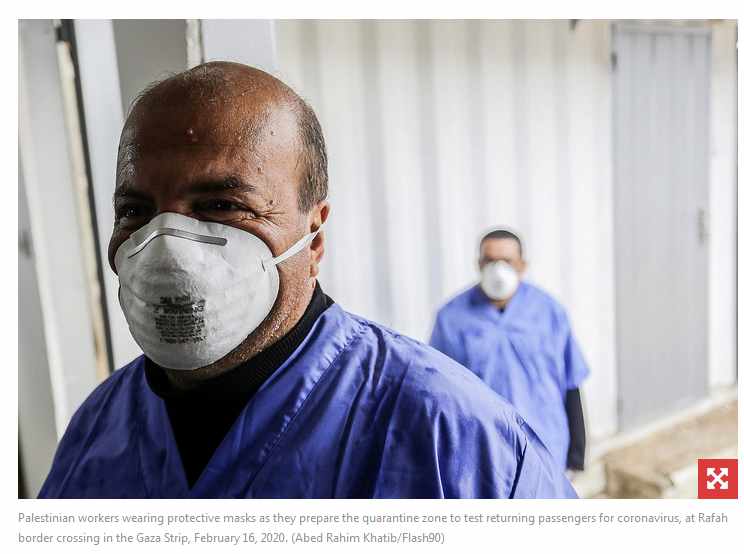
Palestinian workers wearing protective masks as they prepare the quarantine zone to test returning passengers for coronavirus, at Rafah border crossing in the Gaza Strip, February 16, 2020. (Abed Rahim Khatib/Flash90)
What we are facing with self-isolation is nothing compared to the calamity which may strike Gaza. Gaza with 2 million people in an area about 10 square miles is the most overcrowded territory in the world.
Gaza has been under an Israeli siege for the past 14 years as a response to the election of a Hamas administration. Its people are undernourished, its health system lacks medicines and equipment and social distancing is not possible because of the overcrowding.
In addition to all these catastrophes most people are undernourished (or in Israel’s Nazi style language, they are being ‘put on a diet’) because of the blockade.
The blockade must be lifted now otherwise thousands of people could die. Israel’s blockade has become a genocidal blockade and those who claim legitimacy from the Holocaust are, it would seem, prepared to perpetrate another genocide.
Copied below is an article from Israel’s +972 magazine which has had very good coverage of the crisis.

Release all Palestinian Child Detainees Now – Israel is Jeopardising the lives of Palestinian Children as Young as 12
We should also demand that Israeli authorities take immediate action to release all Palestinian child detainees in Israeli prisons amid the COVID-19 virus pandemic.
TAKE ACTION: Demand Israel release all Palestinian child prisoners
Palestinian children imprisoned by Israeli authorities live in close proximity to each other, often in compromised sanitary conditions, with limited access to resources to maintain minimum hygiene routines.
COVID-19’s impact is exacerbated by these conditions, making Palestinian children in Israeli prisons and detention centers increasingly vulnerable.
There is simply no way Israeli prison authorities can ensure the health and well-being of Palestinian child detainees.
Four Palestinian prisoners detained at Israel’s Megiddo prison were placed in isolation after they were in contact with a COVID-19 positive Israeli officer.
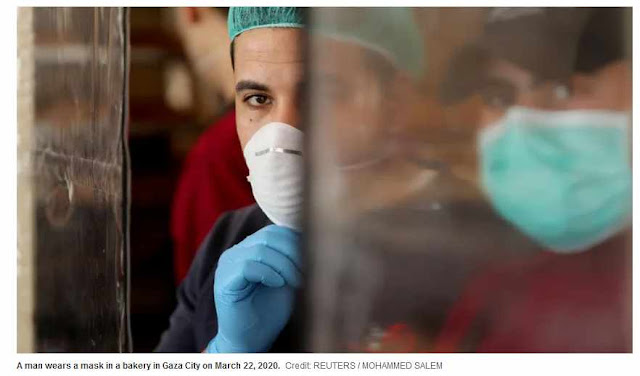
Megiddo prison is one of several detention facilities located inside Israel where Palestinian child “security prisoners” are held.
Israeli authorities must take immediate action to release all Palestinian child detainees in Israeli prisons and detention centers due to the increasing vulnerability created due to the rapid global spread of the COVID-19 virus.
Israeli authorities must take action to safeguard Palestinian children’s rights to life, survival, development, and health in accordance with international law.
Please bombard your MP with demands that they raise these issues now with the government.
See Israel must release all Palestinian child detainees amid COVID-19 pandemic
ALSO Please donate to Medical Aid for Palestine who are on the front line and please email your MP asking that the British government demands an end to the Zionist blockade.
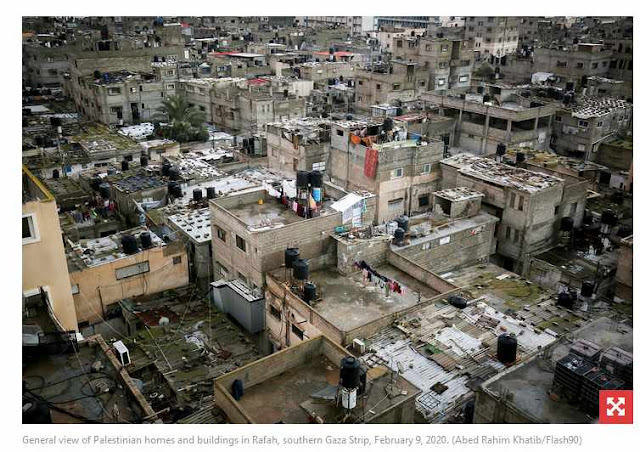
Potential Covid-19 catastrophe in Gaza – Your help is needed
Please support Medical Aid for Palestinians’ current COVID-19 crisis appeal
After 13 years of brutal siege by Israel and Egypt, the healthcare infrastructure in Gaza has all but collapsed. Little equipment and few supplies make their way in, and health professionals are really struggling at the best of times. But if the Coronavirus breaks out in Gaza it could lead to an unimaginable catastrophe for such a densely populated space with so few medical resources.
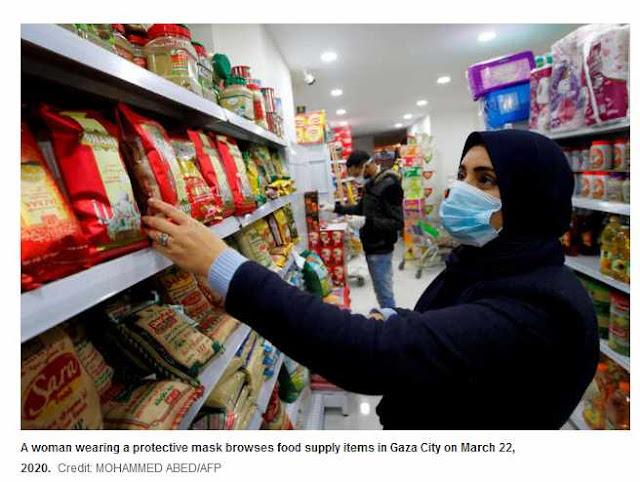
The news today is what we most feared: the first two confirmed cases of the virus in Gaza. Reports here and here.
This follows several weeks of virtually total lockdown of the West Bank, with especially high rates of infection in Bethlehem.
The easiest way for you to donate is via the Facebook page for MAP’s current COVID-19 crisis appeal.
Israel’s caging of Gaza is a recipe for Coronavirus disaster
The pandemic’s arrival threatens to make Gaza even more unlivable under Israeli siege. Humanitarian aid is not enough — Palestinians need freedom.
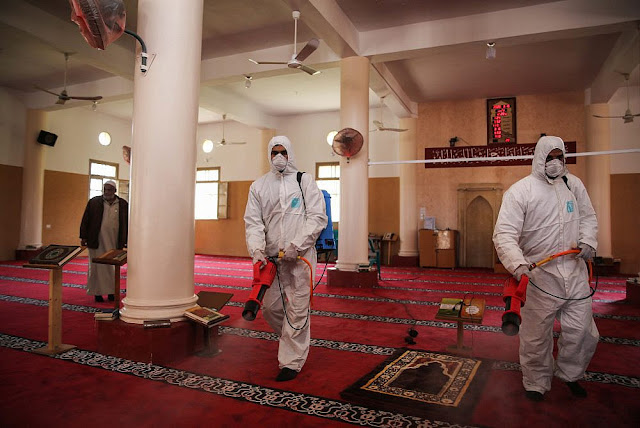
Palestinian Health workers spray disinfectant as a precaution against the new coronavirus in the Al-Omari Mosque in Gaza City. March 15, 2020. (Ail Ahmed/Flash90)
By Jehad Abusalim March 22, 2020
The Palestinian Health Ministry today reported its first two cases of the novel coronavirus in the Gaza Strip. For weeks the Hamas-led authority, which has ruled the blockaded territory since 2007, undertook serious measures to preempt the arrival of the virus to the strip. Up until its decision to seal off its sides of the Rafah crossing with Egypt and the Erez checkpoint with Israel, hundreds of Palestinians who entered the strip were immediately quarantined to ensure they had no symptoms of the disease.
These actions, however, are of very little comfort.
It is no exaggeration to say that the prospect of COVID-19 spreading in the Gaza Strip is terrifying. This year, 2020, is the year in which the United Nations and other international agencies predicted that Gaza would become “uninhabitable.” If Israel’s 13-year blockade and isolation of the strip continued, they warned, Gaza’s most basic services and its capacity to sustain itself would collapse.
As the specter of the coronavirus haunts the strip’s 2 million Palestinian residents, half of whom are children, the world needs to face an urgent truth: Gaza, which has long been unlivable under its current conditions, will be even more so now that the virus has reached its people.
For years, international NGOs, and even some Israeli officials, have warned that Gaza’s health system is on the verge of collapse, incapacitated by decades of systematic de-development, impoverishment, and siege. All the problems of the Israeli blockade are entangled and heightened in Gaza’s health sector: a severe water crisis, an extreme power shortage, high rates of unemployment, and crumbling infrastructure.
As such, Gaza’s healthcare system is not equipped for a COVID-19 breakout. It has a total number of 2,895 hospital beds, or 1.3 beds per thousand people. It has just 50 to 60 ventilators for adults. According to the head of the WHO’s sub-office in Gaza, Abdelnasser Soboh, Gaza is only prepared to handle the first hundred cases of the virus; “After that, it will need further support.”
The health system is further aggravated by the emigration of many Palestinian health professionals due to Gaza’s economic crisis. More than 35,000 Palestinians have left the strip since 2018 alone, among them dozens of doctors and nurses. A Health Ministry official declared they would need at least 300 to 400 more doctors just to close the gap and meet the population’s minimum needs.
Another feature of Gaza’s existence could fuel a mass spread of the virus: population density. According to scientists, “crowded conditions can increase the likelihood of people transmitting infectious diseases” — and with an average of 6,028 persons per square kilometer, Gaza has one of the highest population densities in the world. Its over-crowdedness is only surpassed by a few places, such as Hong Kong; but while people can freely move in and out of Hong Kong, the majority of Palestinians in Gaza are caged there against their will.
Gaza’s eight refugee camps have even higher population densities than the territory’s average. Take Jabalia, where more than 140,000 Palestinian refugees live in an area of 1.4 square kilometers, or about 82,000 persons per square kilometer. The camp has access to just three health clinics and one public hospital. On the land just on the other side of the fence within present-day Israel — where many of the Palestinian refugees are from — the density ranges from zero to 500 persons per square kilometer.
In the shadow of the global pandemic, these conditions in Gaza are a recipe for a disaster. Yet they are not the result of some unfortunate accident; they are a deliberate product of decades of Israeli state policy, consciously designed and maintained to achieve Gaza’s disintegration.
Most of the 2 million Palestinians living in the tiny strip today are descendants of 200,000 refugees who fled or were expelled during the 1948 war that created the State of Israel, joining around 80,000 to 100,000 Palestinians who resided in the area at the time.
These refugees believed that their stay in Gaza would be temporary, but Israel quickly built militarized fences to confine the Palestinians, and enacted laws to make their displacement permanent. These included the 1954 Prevention of Infiltration Law, which deemed any attempt by Palestinians to return to their land, homes, and property as illegal. Many Palestinians who tried to do so were shot and killed by Israeli forces.
When Israel conquered the strip in 1967, it enabled Jewish settlers to take over 25 percent of the already-small territory, comprising about 40 percent of its arable land. Until Israel’s “disengagement” in 2005, four decades of Jewish settlement worsened Gaza’s over-crowdedness and prevented Palestinians from building and expanding within the strip. Since then, repeated Israeli military offensives decimated Palestinian homes and further displaced tens of thousands of families.
Put bluntly, the Gaza Strip is in its current shape because of the logic of Israeli expansionism: the state’s relentless drive to maintain a Jewish majority at the direct expense of the Palestinians. Two million Palestinians are trapped in Gaza not because they chose this life, but because it was forced upon them.
The threat of COVID-19 looming over Gaza is perhaps a last opportunity to say what many refuse to hear: Gaza’s problem is not a lack of humanitarian aid, as urgent as it may be. It is territorial, demographic, and political. It is about who, between the Jordan River and the Mediterranean Sea, is privileged and who is not; who gets to live and thrive on the land, and who does not.

Palestinian students walk past a UN distribution center in the Jabalia refugee camp in the northern Gaza Strip on April 6, 2013. (Wissam Nassar/FLASH90)
Right now, while Israel’s Jewish citizens enjoy the land and its resources, Palestinians are denied that same right and barred from returning to their homeland. And while the international community largely focuses on the threat of Israeli “annexation” of its illegal settlements in the West Bank, many do not care about the unnatural reality experienced by the people in Gaza.
In this time of pandemic and concern for the health of communities worldwide, it is time to address the full consequences of the unjust partition of historic Palestine — and that includes Gaza.
Indeed, Gaza encapsulates many of our world’s problems: war, poverty, displacement, and racism. But it also offers glimmers of hope, through its humanity, resilience, and resistance.
In this moment — when people in more privileged countries can just slightly relate to a life in confinement, separated from loved ones, uncertain about basic needs, and worrying about our collective future — it is imperative to think of places like Gaza, where people have suffered much worse for decades, and are at the risk of a far more devastating blow now that the pandemic has reached their shores.
I write this while thinking about my family in Gaza, who, like many others, may soon be at the mercy of COVID-19. Although this is the time to think about survival, it is also the time to ask big questions, about how we as human beings have failed to prepare for this moment. If this is not the time to end the blockade of Gaza and the occupation of Palestine, and if this is not the time to address the injustices that have rendered Palestinian life to suffering and pain, then when?
Jehad Abusalim is a scholar and policy analyst from Gaza. He is a Palestine Activism Program Associate at the American Friends Service Committee, and is currently studying at New York University.
Doctors Warn of Gaza Strip’s Collapse After First Coronavirus Cases Surface
Medical and human rights organizations call on Israel to lift its blockade of the Strip to boost supplies of medical equipment and protective gear
Jack Khoury Mar 23, 2020 2:19 PM
The announcement Sunday that the first two cases of the coronavirus had been diagnosed in the Gaza Strip transformed the situation there from a state of readiness for the prospect that the virus would surface in the densely populated enclave to a sense of major anxiety.
“We knew that it would reach here too, and that has made everyone tense,” a Gaza resident told Haaretz. Even though the two patients diagnosed in Gaza contracted the virus in Pakistan and have been in isolation since returning, Gazans remain on edge. “Maybe they had contact with an employee at the border crossing or with someone else who is not in quarantine,” another Gaza resident said. “The concern is that we will ultimately lose control, and everything will explode. That’s what’s making everyone anxious.”
In response to the threat, hospitals in the Strip have shut down all of their outpatient clinics.
Following the diagnosis of the first two patients, Israel’s Physicians for Human Rights organization urgently requested that the director general of the Israeli Health Ministry, Moshe Bar Siman Tov, provide assistance to medical authorities in Gaza, including medical equipment that it lacks due to its reliance on Israel. Although the enclave also shares a border with Egypt, Israel controls access to most of the Gaza border crossings.
“Dealing with the corona crisis in the Gaza Strip is dependent upon Israel’s control of the border crossings,” said Ghada Majadle, the director of the occupied territories department at Physicians for Human Rights. “In light of the ongoing siege, Israel is responsible by virtue of international law to provide the required means to the Health Ministry in Gaza.”
Officials said that the Strip has only 70 intensive care hospital beds and that its hospitals are not well-equipped with disinfectant or with masks or protective suits for medical personnel. The international cooperation director of Gaza’s Health Ministry, Dr. Abdul-Latif al-Hajj, also warned of shortages in respirators.
Related Articles
· Coronavirus confirmed in Gaza: This is what Israel must do – now
· Israel considers cutting off parts of East Jerusalem to stem coronavirus spread
· Palestinian prisoners in Israeli jails threaten hunger strike over coronavirus response
Medical professionals in the Strip have expressed concern that the territory lacks the equipment and expertise to address a coronavirus outbreak, particularly in an enclave that is so densely populated. Officials in Gaza and representatives of human rights groups have called for the lifting of the Israeli blockade and for permitting large quantities of medical equipment to be sent in. According to Gaza Health Ministry Spokesman Ashraf al-Qudra, the situation calls for international pressure on Israel to permit the serious shortages of medical equipment to be addressed.
According to accounts given to Haaretz, there has been a significant drop in the number of people on the streets of Gaza City and other major towns in the Strip since the two cases were diagnosed. As in Israel, many Gazans have been stocking up on food, even though there is no shortage. As in the past, it appears that the real problem isn’t a shortage of merchandise, but that many Gazans are strapped for cash.
A mother of five who asked not to be identified by name didn’t conceal her fear over what might be to come: “We constantly hear messages to calm us down, as if everything is under control, but who knows what could happen if the disease explodes? The idea that [even] the major world powers are having trouble dealing with the disease terrifies us.”
Government authorities in Gaza as well as the Hamas Islamist movement are meanwhile attempting to project a sense that things are indeed under control. The police and the security forces affiliated with Hamas have issued new directives banning all gatherings, including people congregating at retail centers, wedding halls, restaurants and cafes, or any place of entertainment.
The Gaza port, including cafes there, has been shut down. Fishermen have been allowed to go out to sea, but the fish market will be closed.
Police have even barred gatherings at mosques and have prevented families from putting up mourning tents following the deaths of loved ones. Weddings cannot be held at either wedding halls or in private spaces. On Sunday, pictures surfaced of a bride and groom wearing surgical masks leaving the bride’s home in the presence of a very small group of friends. They had no party.
Government offices in Gaza have begun operating on an emergency footing, providing only basic services. Only essential staff are coming to work, even at the health and interior ministries.
Of major concern in Gaza is how to prepare the health care system for a major coronavirus outbreak. Large numbers of Gazans who have returned to the territory are in quarantine, including those who have returned from Israel.
According to official data, there are 2,071 residents of the Gaza Strip in home quarantine, in addition to the 1,271 at special isolation facilities. In addition, 637 Gazans have left two weeks of quarantine after it was found that they were not infected. Beyond several existing medical facilities that have been converted to isolation units, 14 isolation facilities have been opened, including two at hotels as well as a closed compound at Rafah.
In the event they are needed, all 700 rooms at Gaza’s hotels and other overnight accommodations will be converted into isolation areas, a senior Gaza Health Ministry official said, and schools would also be used.
The director of Gaza’s outpatient hospital clinics, Dr. Mazin Hinde, said that although border crossings out of Gaza have been shut down, Gazans are still permitted to return to the territory, and they may not understand the seriousness of the situation there. “The problem is that there isn’t sufficient preparation when it comes to the return of patients to Gaza, since they are running the risk of being infected outside [of Gaza] and then infecting others in the Strip. That’s the main concern,” he said.
Medical personnel warn that Gaza was on the verge of collapse even before the pandemic, noting that just five years ago, a United Nations report cautioned that the Strip could become unfit for habitation by 2020. But the coronavirus threat actually surfaced at a time when contacts have been underway with Israel and Egypt in an effort to head off any such collapse.